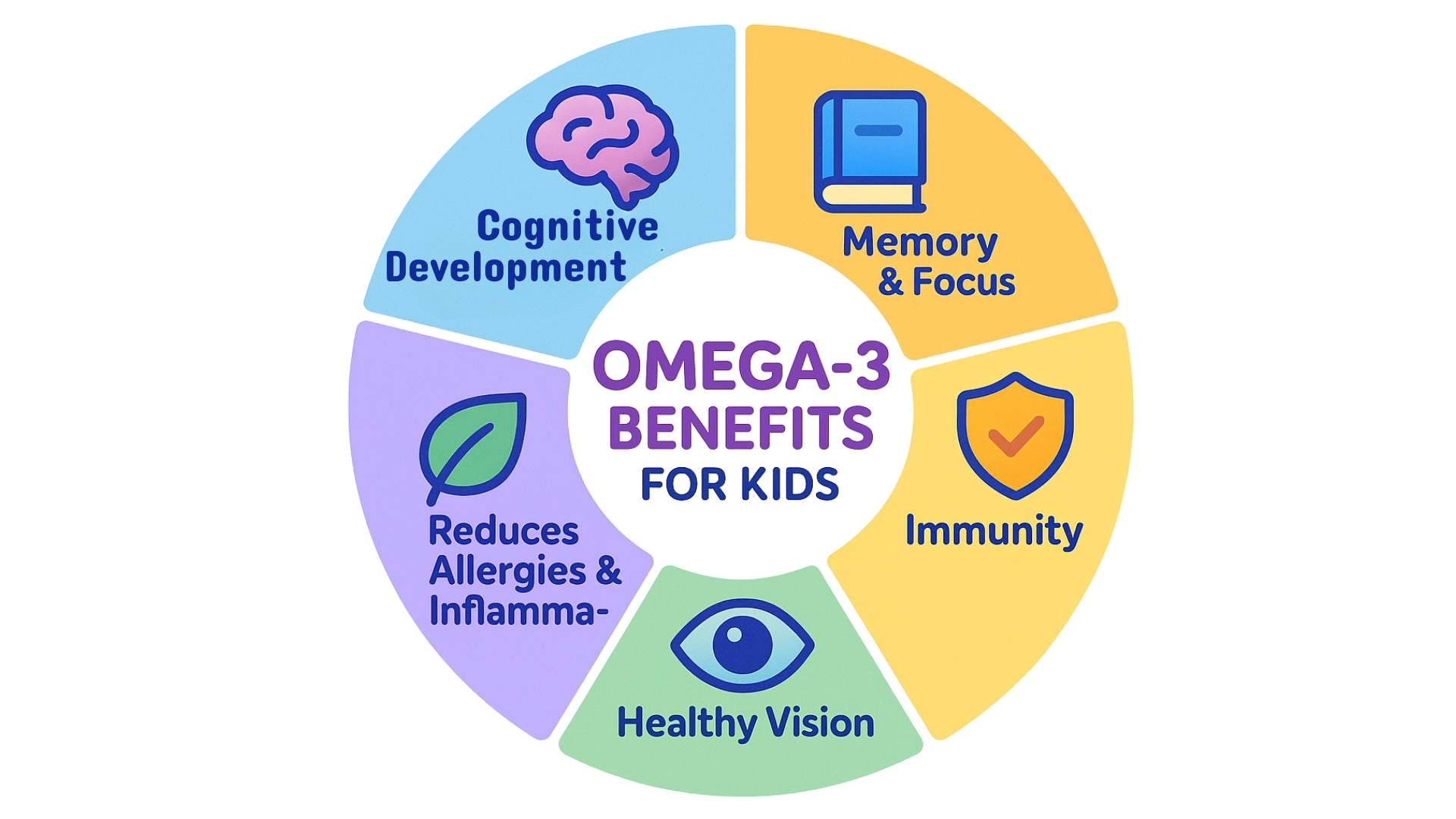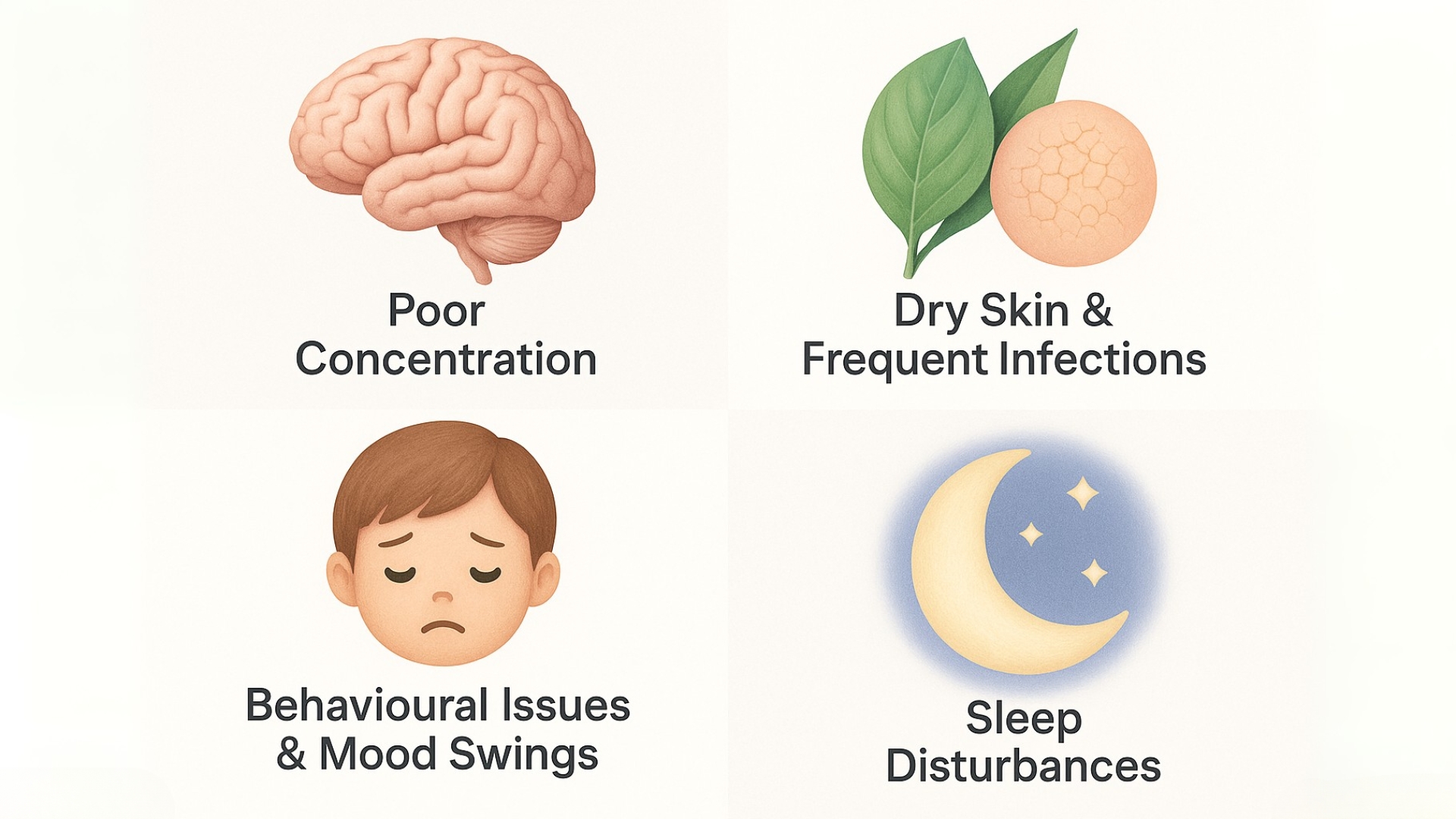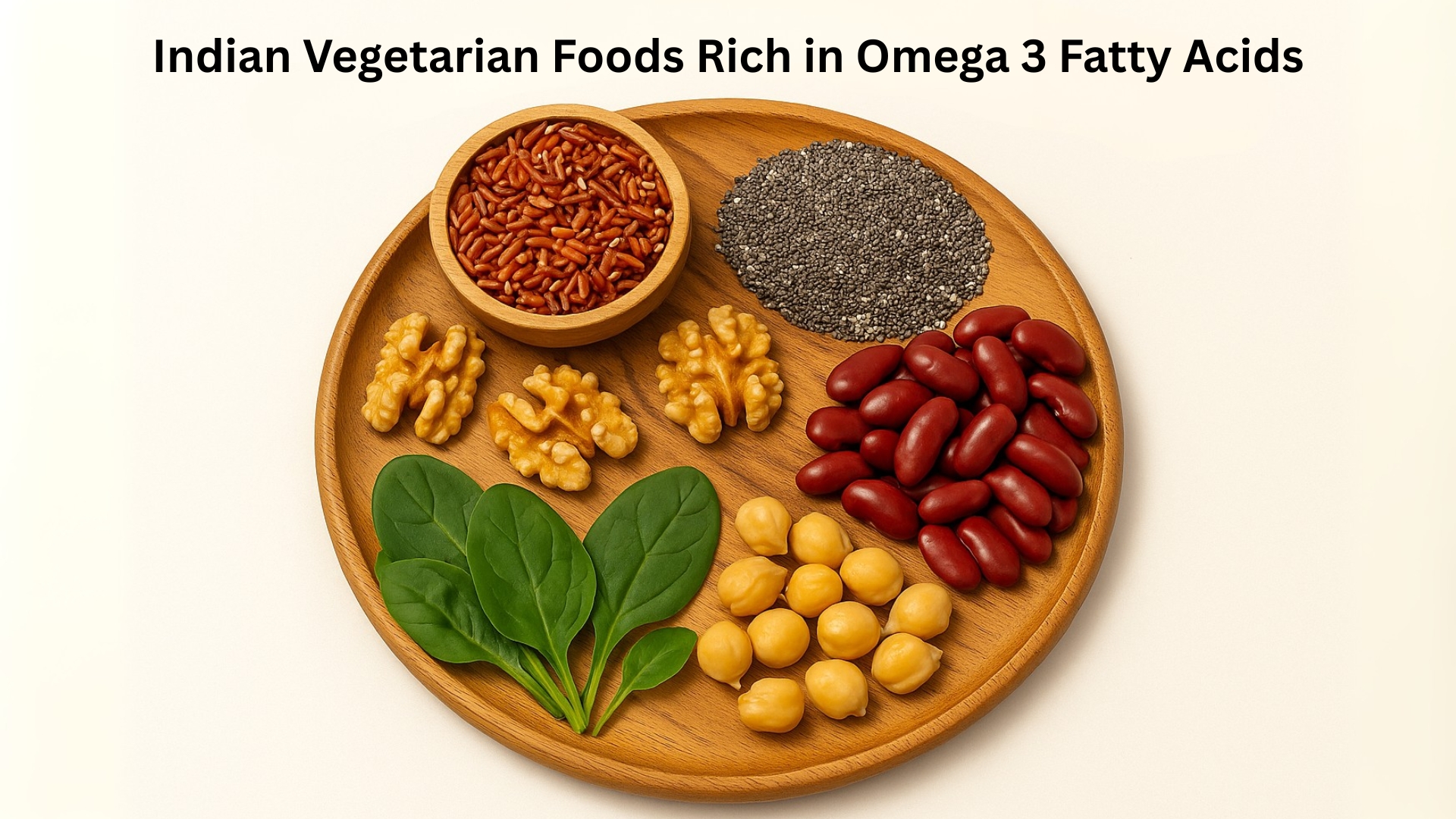Is your child struggling to concentrate, feeling low on energy, or falling sick often? These common concerns can often be traced back to nutritional deficiencies—one of the most overlooked being a lack of omega 3 fatty acids. In today’s busy world, where processed snacks and digital distractions are part of daily life, essential nutrients can easily fall through the cracks. Yet, these nutrients, especially omega 3 fatty acids, play a critical role in supporting your child’s growth, learning, and immunity.
Omega 3 helps in brain development, enhancing memory, boosting mood, improving sleep patterns, and strengthening immunity. These fats are considered “essential” because our body cannot produce them on its own. This makes it important to rely on a diet rich in omega 3 fatty acids or consider options like omega 3 capsules and vegetarian omega 3 supplements, especially when dietary intake falls short.
In this blog, we’ll explore the powerful benefits of omega 3 fatty acids for children and why they are a cornerstone of healthy development. We’ll also walk you through the best source of omega fatty acids, specifically those found in everyday Indian vegetarian foods. Whether you’re looking for foods rich in omega 3 fatty acids or wondering when omega 3 supplements are appropriate, this blog will provide practical, easy-to-follow advice tailored for Indian families.
Let’s unlock the potential of a nutrient-dense, child-friendly diet that fuels sharper minds and healthier bodies—naturally.

What Are Omega 3 Fatty Acids?
Omega 3 fatty acids are a group of essential fats that are absolutely vital for human health—especially in the growing years. The term “essential” means that our bodies cannot make these fats on their own, which is why we must obtain them through a diet or through vegetarian omega 3 supplements.
Types of Omega 3 Fatty Acids
There are three main types of omega 3 fatty acids you should know about: DHA (Docosahexaenoic Acid), EPA (Eicosapentaenoic Acid), and ALA (Alpha-linolenic Acid).
DHA –
While all three offer health benefits, DHA is particularly important for children as it plays a key role in brain development, visual health, and cognitive function. In fact, one of the most widely acknowledged benefits of omega 3 fatty acids is how they contribute to sharper focus, improved memory, and emotional well-being in kids.
EPA –
It is known for its anti-inflammatory properties and supports heart health.
ALA –
It is found primarily in plant-based sources—is converted into DHA and EPA in small amounts. This makes the inclusion of foods rich in omega 3 fatty acids crucial for every child’s daily nutrition. Indian options like flaxseeds, walnuts, and soybeans are some of the best sources of omega fatty acids in vegetarian diets.
If your child is not consuming enough of these through food, you might consider safe supplementation through omega 3 capsules, ideally after consulting a certified nutritionist. After all, omega 3 helps in building not only a healthy body but also a sharp, focused, and emotionally balanced mind.
Benefits of Omega 3 Fatty Acids in Child Development
As parents, we all want to give our children the best start in life—mentally, physically, and emotionally. One of the smartest ways to support that journey is through a diet rich in omega 3 fatty acids, which play a fundamental role in early development. From brain growth to immune strength, the benefits of omega 3 fatty acids are far-reaching, especially during the formative years of childhood.
Here’s how omega 3 helps in shaping your child’s overall health and well-being:

Supports Brain and Cognitive Development:
The brain is nearly 60% fat, and DHA, a type of omega 3 fatty acid, is one of its most important building blocks. Including foods rich in omega 3 fatty acids ensures that your child develops better learning abilities, sharper focus, and faster processing skills. Children who regularly consume omega-3s often perform better academically and socially.
Enhances Memory and Focus:
Whether it’s sitting through school lessons or remembering instructions, omega 3 helps in enhancing memory retention and attention span. It can be particularly beneficial for children with attention difficulties, helping them stay more engaged and less distracted.
Boosts Immunity:
A strong immune system is every parent’s priority. The benefits of omega 3 fatty acids include regulating inflammation in the body, which is crucial for fighting off infections, reducing illness frequency, and supporting faster recovery—especially during seasonal changes.
Supports Healthy Vision:
Vision is closely linked to brain development. Omega 3 fatty acids, especially DHA, contribute to the healthy development of the retina, improving visual clarity and reducing the risk of long-term eye issues.
Reduces Inflammation and May Help with Allergies:
Children today are more prone to allergies and skin conditions like eczema. Including omega 3 fatty acids in their diet can help calm inflammation and reduce allergic responses. In some cases, it may even help manage childhood asthma and eczema more effectively.
Because the body cannot produce these essential fats, they must come from natural foods or trusted sources like omega 3 capsules. For Indian families, flaxseeds, walnuts are among the best sources of omega fatty acids available. Incorporating these into everyday meals ensures your child receives consistent and effective support for their development.
By making small dietary changes today, you can unlock lifelong benefits for your child—because a nourished child is a thriving child.
Signs Your Child May Be Deficient in Omega 3 Fatty Acids
While children grow rapidly, their nutritional needs grow too—and sometimes, subtle signs of a deficiency go unnoticed. One of the most commonly overlooked nutrients in a child’s diet is the omega 3 fatty acid, which plays a crucial role in brain development, immunity, skin health, and sleep regulation. When a child lacks this essential nutrient, the symptoms may not be obvious at first but can gradually impact their daily performance and overall wellness.
Poor Concentration:
One of the earliest signs of omega 3 fatty acid deficiency is poor concentration. If your child is easily distracted, has difficulty focusing in class, or struggles with completing tasks, it might be a red flag. Since omega 3 helps in supporting brain and cognitive functions, a deficiency can make it harder for children to absorb and retain information effectively.
Dry Skin or Frequent Infections:
Another common symptom is dry skin or frequent infections. The benefits of omega 3 fatty acids include their anti-inflammatory properties, which help in maintaining skin hydration and boosting the immune system. If your child is frequently falling sick or dealing with recurring colds, it could indicate that their diet lacks foods rich in omega 3 fatty acids.
Behavioural issues:
such as irritability, frequent mood swings, or even anxiety-like symptoms may also be linked to low omega-3 intake. DHA, a primary form of omega 3 fatty acid, supports emotional regulation and healthy brain signalling. A child who is not receiving enough from a diet rich in omega 3 fatty acids may exhibit sudden changes in behaviour or difficulty coping with stress.
Sleep Disturbances:
Lastly, if your child has sleep disturbances, such as trouble falling asleep or waking frequently during the night, a lack of omega-3 may be a contributing factor. Research shows that omega 3 helps in the production of melatonin, the hormone responsible for regulating sleep cycles.
To address these symptoms early, it’s important to assess your child’s daily intake of foods rich in omega 3 fatty acids. If diet alone isn’t enough, safe and age-appropriate vegetarian omega 3 supplements—under the guidance of a certified nutritionist—can help bridge the gap. For Indian households, incorporating flaxseeds, walnuts, and mustard oil into meals can offer some of the best sources of omega fatty acids naturally.

Understanding these warning signs is the first step toward protecting your child’s health and unlocking the full benefits of omega 3 fatty acids through thoughtful nutrition.
Indian Vegetarian Foods Rich in Omega 3 Fatty Acids
In a country like India, where vegetarian diets are widely practiced, meeting essential fatty acid needs—especially omega 3 fatty acids—can feel challenging. However, nature has blessed us with a variety of Indian vegetarian options that are not only delicious but also excellent foods rich in omega 3 fatty acids. By including these in your child’s daily routine, you can easily build a diet rich in omega 3 fatty acids without always turning to omega 3 capsules or supplements.
Let’s explore some wholesome, everyday Indian foods that serve as the best sources of omega fatty acids, especially for plant-based diets:
Flaxseeds (Alsi):
Flaxseeds are a powerhouse of ALA (Alpha-linolenic acid), a type of omega 3 fatty acid that the body can convert into DHA and EPA in small amounts. These tiny seeds are incredibly versatile and can be added to parathas, rotis, or even blended into homemade laddoos. Just roast and grind them into a powder for easy daily use. Beyond their omega-3 content, flaxseeds also aid digestion and support heart health, making them a staple in any diet.
Chia Seeds:
Often called a “superfood,” chia seeds are one of the richest source of omega 3 found in nature. A single spoonful can deliver a significant amount of ALA. Mix them into curd, oats, or fruit smoothies for a child-friendly, nutrient-dense treat. These seeds are also packed with fiber and protein, making them a well-rounded choice for growing kids.
Walnuts:
Crunchy, delicious, and full of brain-boosting nutrients, walnuts are among the best and tastiest foods rich in omega 3 fatty acids. They make an ideal school tiffin snack—just a handful a day can support better focus, memory, and mood. For children who avoid fish or eggs, walnuts act as a great plant-based alternative to maintain a balanced diet rich in omega 3 fatty acids.
Soybeans:
Soybeans are not only rich in protein but also a good vegetarian source of omega 3 fatty acids. They can be cooked into sabzis, tossed into salads, or even ground into flour and added to dosa batter or chapatis. Their versatility makes them a convenient way to add both protein and healthy fats into your child’s meals.
Rajma (Kidney Beans):
Yes, the humble rajma curry—one of India’s favourite comfort foods—is also a brain-nourishing meal! Rajma contains modest amounts of omega 3 fatty acids and, when combined with rice or roti, forms a complete meal that supports cognitive health. Rich in iron and fiber too, rajma is a great way to sneak in some omega-3 while keeping the plate familiar and comforting.
While plant-based options offer great nutritional benefits, it’s important to note that the body converts ALA (plant-based omega-3) to DHA and EPA less efficiently. This is why, in some cases, your nutritionist may recommend vegetarian omega 3 supplements, especially for children with higher developmental needs.

Including these foods regularly can help to unlock the full benefits of omega 3 fatty acids in a child’s physical, emotional, and cognitive development. And the best part? All of these options are affordable, accessible, and rooted in traditional Indian cuisine.
Bonus Tip: Use cold-pressed mustard or flaxseed oil in cooking to further boost your child’s omega-3 intake naturally.
Easy Ways to Incorporate Omega 3s into Your Child’s Daily Diet
Including omega 3 fatty acids in your child’s diet doesn’t have to be complicated. With a few smart choices and a little creativity, you can turn everyday meals into nutrition-packed power plates. The key is consistency—ensuring your child enjoys a diet rich in omega 3 fatty acids across all meals, from breakfast to dinner. Whether you’re preparing tiffin for school or planning family dinners, these ideas will help you naturally include more foods rich in omega 3 fatty acids in your child’s routine.
Omega-3-Rich Breakfast Ideas
Start the day right with omega-3 power! Breakfast is the perfect opportunity to introduce healthy fats. You can add ground flaxseeds or chia seeds to atta (flour) for making parathas or rotis, or stir them into warm porridge. A banana-chia smoothie or walnut-stuffed whole wheat toast is another child-friendly option. These are all excellent foods rich in omega 3 fatty acids that are also easy on the palate.
A spoonful of chia seed pudding soaked overnight in milk with fruits and nuts is a tasty, grab-and-go breakfast that delivers the full benefits of omega 3 fatty acids—brain boost, improved focus, and better digestion.
Snack Box Suggestions for School
Children love crunchy, tasty snacks—so why not make them nourishing too? A small handful of walnuts, roasted soybeans, or flaxseed ladoos are perfect additions to the school tiffin. Homemade trail mixes with dry fruits and seeds are not just delicious but also among the best sources of omega fatty acids in vegetarian diets.
You can also sneak in some omega 3 fatty acid goodness by spreading peanut or walnut butter on multigrain crackers or adding ground flaxseed to homemade muffins or pancakes.
Creative Lunchbox Options with Indian Recipes
Lunch doesn’t have to be boring to be healthy. Try rajma-chawal, soyabean sabzi, or spinach and flaxseed-stuffed theplas—all rich in plant-based omega 3 fatty acids. You can also blend flaxseed powder into dal, mix chia seeds in curd rice, or toss cooked soybeans into poha and upma.
Rotating these dishes throughout the week ensures your child enjoys a diet rich in omega 3 fatty acids while also staying connected to familiar Indian flavors.
Use of Supplements (With Professional Guidance)
Despite your best efforts, some children may still fall short of meeting their omega-3 needs through diet alone—especially if they’re picky eaters. In such cases, vegetarian omega 3 supplements can be considered under the guidance of a certified nutritionist. These supplements provide concentrated forms of omega 3 fatty acids, especially DHA and EPA, which are critical for brain, eye, and immune development.
Always choose high-quality, age-appropriate options, and consult a pediatric nutrition expert to tailor the dosage and timing. At MotoNutrition, we specialize in evaluating and customizing your child’s nutrition plan so they receive the complete benefits of omega 3 fatty acids safely and effectively.

From breakfast to bedtime snacks, these easy meal upgrades ensure that omega 3 helps in shaping a healthier, sharper, and happier child. With the right foods—and sometimes, the right supplements—you can turn nutrition into a daily ritual of growth and wellness.
When to Consider Omega 3 Supplements
While it’s always best to rely on natural foods rich in omega 3 fatty acids, there are situations when supplementation becomes not just helpful—but necessary. Some children may have dietary restrictions, allergies, or simply be picky eaters, making it difficult to maintain a consistent diet rich in omega 3 fatty acids. In such cases, adding vegetarian omega 3 supplements may help bridge the nutritional gap and ensure optimal growth and development.
Omega 3 fatty acids—particularly DHA and EPA—are critical for brain function, emotional balance, and immunity. If your child shows signs of deficiency such as poor concentration, frequent illness, behavioural changes, or developmental delays, it may be time to consult a professional. That’s where trusted, evidence-based guidance becomes essential. Omega 3 helps in improving focus, sleep quality, and emotional well-being, making it a cornerstone nutrient in early life nutrition.
However, not all supplements are created equal. It’s important to choose the right form, source, and dosage depending on your child’s age, lifestyle, and health goals. This is why it’s strongly advised to always consult a certified nutritionist before starting any supplement routine—especially when it involves omega 3 capsules or oils.
At MotoNutrition, we offer personalized dietary guidance for children, ensuring that every recommendation is tailored to your child’s unique needs. Whether your child is vegetarian, has allergies, or requires special support for learning or immunity, we help determine if vegetarian omega 3 supplements are necessary and how to incorporate them safely alongside a diet rich in omega 3 fatty acids.
Remember, supplements should never replace whole foods but rather support and enhance a well-balanced diet. For children who aren’t getting enough through natural sources like flaxseeds, walnuts, or soybeans—the best sources of omega fatty acids in a plant-based diet—supplementation can provide a safe and effective boost when done right.
FAQs
Q1. What are omega 3 fatty acids, and why are they important for kids?
- A. Omega 3 fatty acids are essential fats that support brain development, vision, and immunity in children. Since the body cannot produce them, they must be obtained through a diet rich in omega 3 fatty acids or supplementation.
Q2. Which are the best vegetarian sources of omega-3 for children?
- A. Foods rich in omega 3 fatty acids for vegetarians include flaxseeds, chia seeds, walnuts, soybeans, and rajma. These are some of the best sources in a plant-based Indian diet.
Q3. Can my child get enough omega-3 from food alone?
- A. Many children can meet their needs through a balanced diet rich in omega 3 fatty acids, but picky eating or dietary restrictions may require additional support from vegetarian omega 3 supplements.
Q4. What are the signs of omega-3 deficiency in children?
- A. Common signs include poor concentration, dry skin, frequent infections, sleep disturbances, and behavioural issues. These symptoms may indicate a lack of omega 3 fatty acid intake.
Q5. How does omega 3 help in brain development?
- A. Omega 3 helps in building brain cells and improving communication between neurons, especially DHA, which is essential for memory, focus, and cognitive development.
Q6. Are omega 3 capsules safe for children?
- A. Yes, omega 3 capsules can be safe when age-appropriate and recommended by a certified nutritionist. Always choose trusted, child-safe formulations.
Q7. How do omega-3s benefit a child’s immune system?
- A. One of the key benefits of omega 3 fatty acids is their anti-inflammatory effect, which helps strengthen the immune system and reduces the frequency of infections.
Q8. Is there a difference between plant-based and fish-based omega-3s?
- A. Yes. Plant-based sources provide ALA, while fish-based options offer DHA and EPA. Both are valuable, but the body converts ALA to DHA/EPA inefficiently, which is why some children may benefit from vegetarian omega 3 supplements.
Conclusion
From supporting sharper thinking to strengthening immunity and emotional well-being, the benefits of omega 3 fatty acids for children are simply too important to ignore. Whether it’s DHA fueling brain development or ALA contributing to heart and skin health, it’s clear that omega 3 helps in laying the foundation for a healthier, more balanced childhood.
While Indian diets offer many foods rich in omega 3 fatty acids, ensuring your child gets an adequate and consistent intake requires intentional planning. This becomes even more crucial for vegetarian families, where the primary reliance is on plant-based options. Thankfully, with smart choices like flaxseeds, walnuts, chia seeds, and soybeans—some of the best sources of omega fatty acids—and the guidance of a qualified expert, your child can still enjoy the full spectrum of omega-3 benefits through a diet rich in omega 3 fatty acids.

In some cases, when dietary intake is not enough, the use of omega 3 capsules may be recommended. However, it’s important to approach supplementation with care and professional advice to make sure it’s both safe and effective.
At MotoNutrition, we are deeply committed to optimizing children’s health through personalized nutrition plans. We understand that every child is different, and our expert-led programs are designed to offer the right balance of whole foods, natural nutrients, and supplements when needed.
Want to know if your child is getting enough omega-3s? Let’s take the guesswork out of it. Contact MotoNutrition and book a consultation with our experienced pediatric nutritionist, Deepti Gupta, to assess your child’s needs and help them thrive with the right nutrition.
For more information, go to our Homepage.